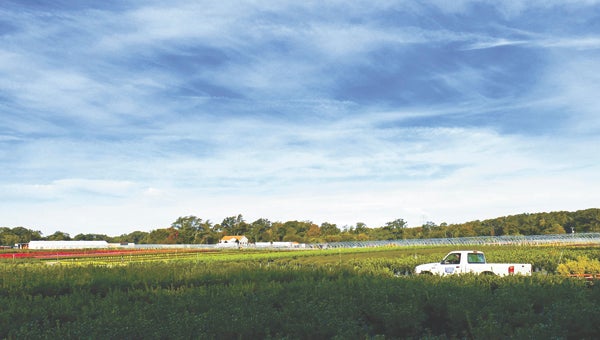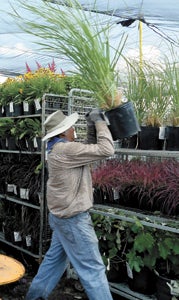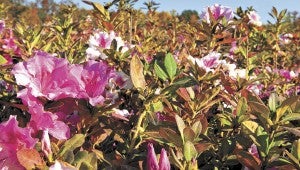Green thumbs
Published 8:15 pm Tuesday, March 17, 2015

Lancaster Farms’ wholesale nursery has its main location on about 150 acres along Knotts Neck Road, off Bridge Road in North Suffolk. The company serves landscapers and other corporate and government clients throughout the Mid-Atlantic region. (Submitted Photo)
Lancaster Farms: Gardening on a grand scale
With winter now a memory most folks in Suffolk would rather forget, things are starting to pick up in the fields alongside Knotts Neck Road in North Suffolk.
Where long stretches of “hoop houses” sheltered shrubs, groundcover and trees from one of the coldest winters in Virginia’s modern history, the structures are now either gone or are being dismantled, and the plants they’d covered are stretching toward sunshine that had been mostly a memory since late fall or early winter.

With an average of about 100 employees, depending on the season, Lancaster Farms is one of Suffolk’s biggest companies, but the wholesale nature of its business means many people are unaware of the more than 750 different plant species the nursery has available. (Submitted Photo)
Homeowners and businesses around the Mid-Atlantic are looking for professional help to spruce up their properties after a long, hard winter, and scores of horticulturalists, production and shipping staff, and sales and support professionals at Lancaster Farms have shifted into high gear to provide the plants those landscaping professionals will need to get the jobs done.
“This is where all the magic happens,” Marketing Manager Christina Keeling says from a conference room in an administrative building at the center of the company’s main location.
The company has two other sites — the Murphy’s Mill farm, where trees are raised, and the Pitchkettle Road farm, which generally serves as extra space. But the 150-acre Knott’s Neck location, located right off Bridge Road since it was founded there by Charlie Parkerson in the 1969, is the face of Lancaster Farms.
Over the course of 46 years, it has become a familiar face.
In fact, Lancaster Farms might be one of Suffolk’s best-known businesses that’s generally not open to the public.
With the exception of a small Plant Outlet that has served retail customers during the spring and fall for the past couple of years, Lancaster Farms is a wholesale-only business.
Prime customers, according to Keeling, are landscapers, independent garden centers, municipalities, colleges and garden-industry professionals.
But even when selling shrubs, trees and flowers to landscaping professionals, Lancaster employees are ever mindful of customers at the end of the distribution chain who are “looking to build an atmosphere” around their homes and businesses.
“I don’t think gardens are going away,” Keeling says. “They’re just morphing into this new thing people want to achieve. Landscaping makes another living space.”
Keeling’s degree is in marketing, and she had no horticultural experience when she joined Lancaster Farms a year or so back. Things have changed for her since then.

Plants are made ready for shipping at Lancaster Farms, which specializes in species that are hardy in Tidewater. (Submitted Photo)
“Once you’ve started working at a place like this, it’s kind of hard not to like plants,” she says. “We believe in the power of plants. They really do make a difference.”
At Lancaster, the difference plays itself out over more than 750 different species for sale. The company catalogue is a riot of color on slick, thick paper, and there’s even a staff photographer to capture the images. “Most nurseries don’t have something like this,” Keeling says.
But when the temperatures rise and the daylight hours stretch out, the printed catalog is worth all the trouble, as it becomes a wishbook for landscaping pros looking for plants that are especially acclimated to the Tidewater climate.
“We consider ourselves an open-air nursery,” Keeling says, explaining the fact that the company operates only one permanent, fully climate-controlled greenhouse, used for propagating plants.
“You know that the plant your landscaper gets from us — that was grown here in our Suffolk environment — will thrive. We’re proud of the quality we can produce.”
Among the nursery’s most popular products are crepe myrtles, azaleas, hostas, hydrangeas and gardenias, Keeling says, and all of those plants do quite well in plant hardiness Zones 7 and 8, which encompass most of Tidewater.
“We’re always trying to beautify Hampton Roads,” Keeling quips. “We like to say, ‘If our customers grow, we grow.’”
Part of the growth at Lancaster Farms in recent years has come from a desire to branch out and try new things. The Plant Outlet is one example.
“We wanted to encourage the public to feel like they can come in here now,” Keeling says, so space for the setup was cleared as close to Bridge Road as possible, and a farmers’ market was started last year, running weekends from August to October, to help attract folks to the new retail space.
This year, Keeling says, the farmers’ market will start up in May, featuring produce and meat vendors, as well as Suffolk artisans. Keeping the market locally focused is important, she adds, noting that 90 percent of the vendors last year came from Suffolk.
For 2015, “My hope is to have 20 vendors here every market,” she says.
The trick, she notes, pointing at the space where the market will operate — right next to the Plant Outlet — will be for folks to realize the old wholesale-only rule doesn’t apply on this little piece of the farm.






